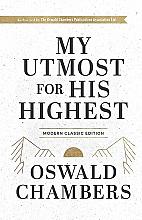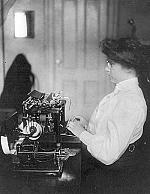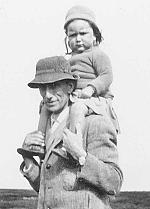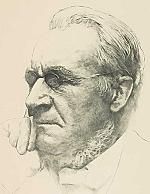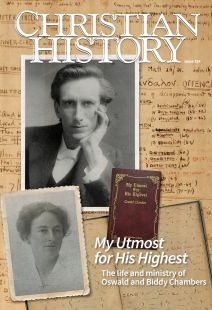Making My Utmost
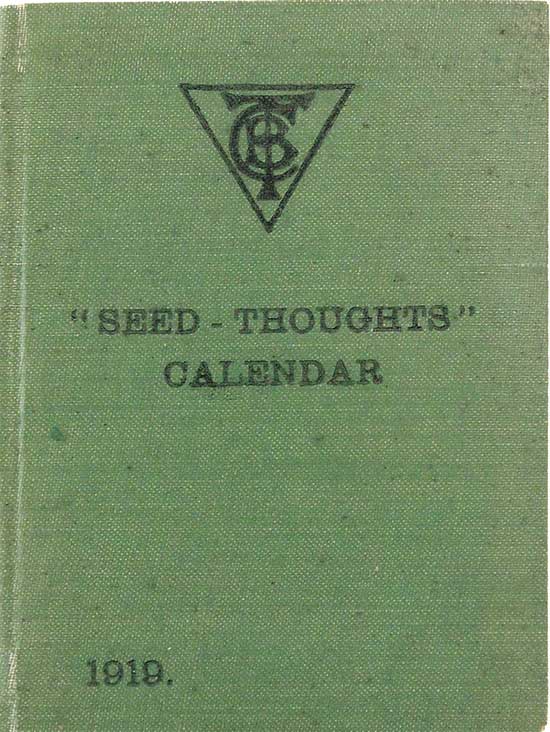
[Above: Oswald Chambers, Seed Thoughts Calendar, 1920—Photo by Max Pointner / Wheaton College Archives & Special Collections]
As I take in the large townhouse before me in north London, I think about Biddy Chambers, a widow living behind these bricks who walked these same streets some decades before me. Of her standing at the top of the nearby hill, gazing at the rows of closely gathered steeples and the view beyond to the skyline of London. Of her sending to missionaries and friends copies of the recently published book that she compiled, edited, and published, My Utmost for His Highest. I think of her role in this now best-selling devotional by Oswald Chambers—a book the author didn’t even know about.
AN UNLIKELY CALLING
In their limited time together, Oswald and Biddy lived their utmost for God’s highest everywhere God took them. Throughout it all, Biddy embodied her nickname, “Beloved Disciple,” as she shared Oswald’s calling to minister to those they met with God’s love.
But Biddy also exercised her skills of word-perfect stenography, and when she met and married Oswald, she focused on capturing through shorthand his life-giving talks and lecture notes. She eventually had a treasure trove (including actual trunks of papers) of squiggles and marks that documented every talk, sermon, and lecture she heard him deliver over the course of their marriage.
The couple never imagined such a wide reach for Oswald’s work, but Biddy produced pamphlets, booklets, and eventually books in response to the demand of readers. The first published were Oswald’s sermons that Biddy prepared for publication in the League of Prayer’s magazine (with which they were associated). Then when Charles Rae Griffin (1881–?), the director of a small publishing company, heard one of Oswald’s lectures at the Bible Training College, he immediately wanted to share this wisdom with others. After Biddy edited, compiled, and typed the content, Griffin distributed the pamphlets to a warm reception through the London Baptist Missionary Union.
Other connections in Britain and the United States clamored for Oswald’s teaching, and in 1912 Oswald’s first book was published, Biblical Psychology. Yet far from being an eager first-time author, Oswald focused on the people in front of him. Neither he nor Biddy ever sought financial compensation for the works they produced.
BAFFLED TO FIGHT BETTER
After her husband’s unexpected and untimely death in 1917 in Egypt, Biddy continued to send out his sermons and lectures, now to comfort their bereft and shocked friends around the world. Even in her grief, she sought to encourage others with Oswald’s words, dedicating herself to the calling she embraced for the many remaining years of her life.
She and Kathleen stayed in Egypt for two years after Oswald died as she continued to provide hospitality to the soldiers and share from Oswald’s materials. With confidence and clarity, she said to the men gathered, “Oswald is not here to teach us and so we will learn together now.” She had already sent Baffled to Fight Better, a study written specifically for soldiers, to the printer. It was published just one month after Oswald died. Biddy also sent out monthly sermons to soldiers, friends, and missionaries as part of her wide correspondence. The response was overwhelmingly positive, and eventually the YMCA sent out 10,000 copies each month of Baffled and other sermons.
After the war ended, she and her now six-year-old daughter moved back to England in June 1919. Eventually settling in Oxfordshire, Biddy earned a meager salary through running a clean and safe boarding house for university students and making meals for them. She somehow also found the time and energy—usually at night after Kathleen was asleep—to compile, edit, and distribute Oswald’s words of encouragement and conviction. Even though Kathleen was reduced to accepting worn and stained clothes from well-wishers, Biddy would always put any money received from the publications into the next round of printing and distribution costs.
Biddy’s first project back in England seems like a precursor to My Utmost; she compiled 366 short and pithy thoughts into what she called a Seed Thoughts Calendar. Two sample entries embody Oswald’s characteristically vivid and straight-talking devotion to Christ: “Grousing destroys generosity like a moth does a garment, slowly but completely” (March 1). And, “The people who are always desperately active are a nuisance; it is through the saints who are one with Him that God is doing things all the time” (October 4).
Biddy presented the idea for this short work, complete with four months of sayings, to a publishing contact of Griffin’s. But the publisher didn’t catch the vision for the book, turning down the idea on the spot. Crestfallen, Biddy described feeling “undone” by the meeting. Yet after time to pray and process, she realized that not going with a traditional publishing arrangement left her at “liberty only to go along the lines of spontaneous moral originality.” Although she would not have claimed the title, she eventually became a boutique independent publisher who produced more than 40 books, based on Oswald’s teaching, in her lifetime, including the one most known and loved, My Utmost for His Highest.
For the years of their marriage, Biddy and Oswald started each day with a shared time of prayer and reading the Bible and the Daily Light devotional, a compilation of Scripture passages arranged by theme. Perhaps inspired by the encouragement they received through this small devotional, Biddy determined to create a through-the-year resource to help believers stay committed to Jesus.
As she shared in the book’s introduction, Biddy included content from Oswald’s lectures at the Bible college and his talks in Egypt. Translating her shorthand notes, she then edited several talks into each day’s reading of around 500 words each—all the while running the boarding house. The book’s style follows how Oswald wrote and spoke during his lifetime—deep and yet understandable, compassionate while calling readers to confess sin, realistic about suffering and yet enduringly hopeful.
The work took her three years to complete, and when in 1927 she had finished the typing, compiling, editing, and proofreading, she arranged, through gifts from friends, for the funding of the first edition. Her presentation of Oswald’s words immediately resonated with readers, reaching a broad Christian audience and crossing many denominational lines. As demand for this compelling new devotional soared, she realized that its distribution was beyond her capabilities and she entrusted a London firm with the task.
LABOR OF LOVE
Throughout the writing and editing of My Utmost, Biddy kept a low profile about the book, not least with her teenaged daughter, Kathleen. Years after Biddy had died, Kathleen remarked to David McCasland, Chambers’s biographer,
She never talked about the books to me. She didn’t want me to have anything to do with the books. I was going to be a nurse and the books were her job. . . . But my mother got the books out into print and she typed and retyped and typed and typed and she read all the proofs herself.
Biddy never claimed her title as editor or compiler of this work, or for any of the many books she created from her notes of her husband’s talks. Even her introduction to My Utmost bears only her initials, “B. C.,” and not her name. She never sought the limelight, instead wanting to work for God’s glory while remaining hidden in Christ. She adhered to Oswald’s admonition in The Dedication of Following:
[W]hen we are following Him, it will be a matter of indifference whether God puts us in the forefront or in the back seat. When we realise this, then the joy of the Lord is ours because we are fulfilling our regenerated purpose.
Biddy held what’s sometimes called a “holy indifference” even to the published books she’d labored so hard to create, as evidenced in 1940 when during the Blitz a bomb destroyed a book warehouse close to St. Paul’s Cathedral. When she received the news that all 40,000 copies of various works were lost—none being insured—she set down her teacup and remarked to Kathleen, “Well, God has used the books for His glory, but now that is over. We’ll wait and see what God will do now.” (Eventually, the books were reprinted and have remained in print ever since; see pp. 28–30.)
From stenographer to compiler and editor to proofreader to publisher, Biddy was years ahead of her time in conventional publishing terms. Yet she didn’t think of her life that way, of course. She simply loved and served God, seeking each day to give her utmost for his highest. CH
By Amy Boucher Pye
[Christian History originally published this article in Christian History Issue #154 in 2025]
Amy Boucher Pye is the author of six books, including 7 Ways to Pray, a speaker, and spiritual director. She has been associated with the Oswald Chambers Publications Association (OCPAL) for eight years. She and her family make their home in north London, not far from Muswell Hill, where Biddy once lived.Next articles
From typewriter girl to publishing powerhouse
Changes in “women’s work” led to Biddy’s “ministry of the books”
Katherine Goodwin LindgrenMy search for Oswald Chambers
Discovering the man behind My Utmost for His Highest
David C. McCaslandSupport us
Christian History Institute (CHI) is a non-profit Pennsylvania corporation founded in 1982. Your donations support the continuation of this ministry
Donate



